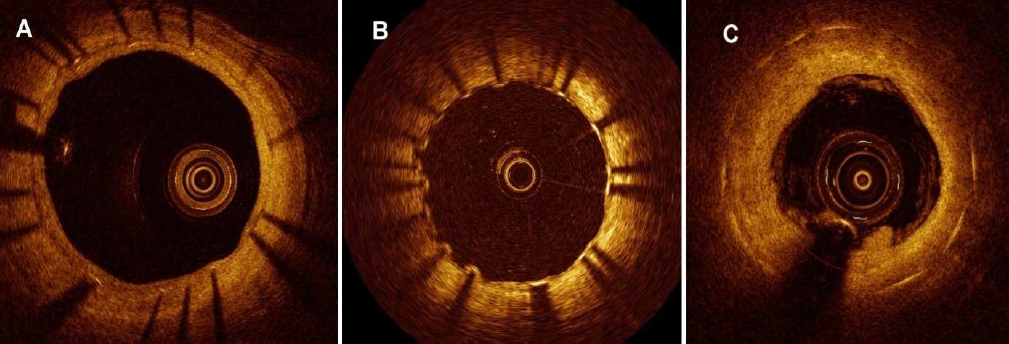Cardiology and vascular diseases
The project
Financing of an innovative imaging technique, OCT (optical coherence tomography), used in the framework of the coronary angioplasties called CTO (chronic total occlusions) of the coronary artery.
The project leader
Doctor Sébastien Levesque, cardiologist of the Poitiers CHU, co-leader of the cardiology intensive care unit.

Examples of OCT analyses of stents at 6 months:
A : Fine and homogeneous covering of stent meshes.
B : Insufficient covering with the meshes remaining exposed in the vessel lumen: “serrated” aspect.
C : OCT aspect of restenosis. The endothelial cover is too large, reducing in size the residual lumen.
Project details
The Aliénor endowment fund helps to finance research projects and medical innovations at the Poitiers CHU. The activity of the cardiologist has been selected by the scientific committee to receive financial support from the endowment fund.
Co-leader since 2012 of the cardiology intensive care unit, Doctor Sébastien Levesque officiates in the coronary and structural interventional cardiology unit. His research project is designed to evaluate an innovative imaging technique, known as OCT, for the placement and implantation of coronary stents in complex situations.
In the general framework of coronary pathologies, stent placement may be necessary; in this precise case, we term it coronary angioplasty. The device used has the form of a metal spring, tubular and meshed, and is implanted by the cardiologist in the coronary artery in such a way as to keep it open. The procedures are more complex and entail additional risk when arteries have been occluded for several weeks or months.
OCT (optical coherence tomography) is an extremely precise intracoronary imagery technique guided by infrared laser. Carried out following an angioplasty, OCT permits fine analysis of the stent’s position, achieving 10-micron resolution. It highlights the causes of stent thrombosis when it occurs and can also help to prevent stent thrombosis by targeting and correcting poorly positioned stent “landing zones”. Poor positioning of a stent may negatively affect artery wall healing and can provoke medical complication (re-infarctus, death).
Carrying out OCT three months after a CTO procedure, this study will provide description of the positioning and the re-endothelialization of the stents. Simply speaking, it will be a matter of understanding the evolution of the stents after chronic total occlusion of the coronary artery. If, for example, poor placement is detected, the cardiologist should be able to more effectively correct it.
All in all, 150 patients should be subjected in OCT imaging, and each one of them will be monitored for a year. The study will go on for three years. In addition to improved post-operative follow-up, this imagery technique is likely to lead to significant reduction of middle and long-term complications.

Co-leader since 2012 of the cardiology intensive care unit of the Poitiers CHU, Doctor Sébastien Levesque officiates in the coronary and structural interventional cardiology unit. He carried out his medical studies in the Tours CHU, and started his professional activity at the Clermont-Ferrand CHU.


